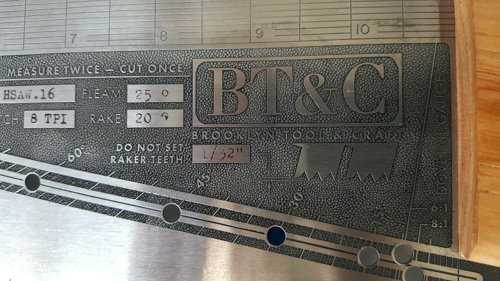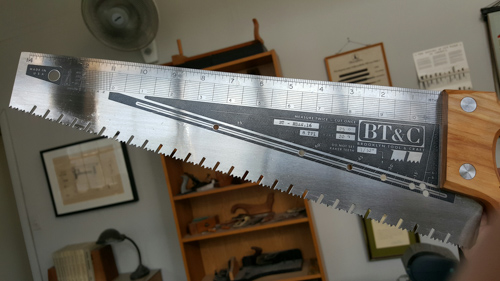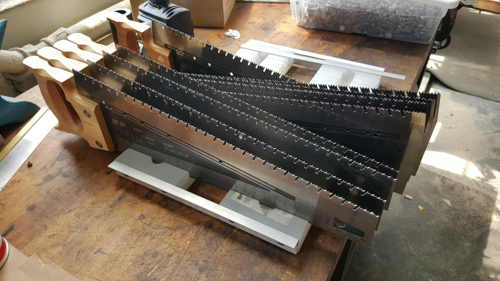|
|
05/15/2015 |
 There still is a lot of innovation in hand tool design - innovation that ranges from tweaks to completely new approaches in design and manufacture. Modern makers of tools, all of us, are using new materials and new manufacturing techniques to advance tool performance and tool appearance. The hand tool innovators of the 19th century did the same and did their best to industrialize handtool manufacture and wring the most performance from human-powered machinery. They did a great job. It's always been the philosophy at TFWW to look to the past for direction, and then push forward using the advantages we have today. Two years ago, at the first Handworks show in Amana, Iowa, we got a chance to see a real Montague-Woodrough handsaw. The saw, made by a small competitor of the giant saw companies of the time (Disston, Atkins & Simmonds), had an innovative tooth design that ripped brilliantly, crosscut smoothly in hardwood, and while looking bizarre, was no more difficult to sharpen by hand than any other good saw. It probably didn't succeed in the marketplace due to its lack of distribution and the difficulty of sharpening it using the machines available at the time. There still is a lot of innovation in hand tool design - innovation that ranges from tweaks to completely new approaches in design and manufacture. Modern makers of tools, all of us, are using new materials and new manufacturing techniques to advance tool performance and tool appearance. The hand tool innovators of the 19th century did the same and did their best to industrialize handtool manufacture and wring the most performance from human-powered machinery. They did a great job. It's always been the philosophy at TFWW to look to the past for direction, and then push forward using the advantages we have today. Two years ago, at the first Handworks show in Amana, Iowa, we got a chance to see a real Montague-Woodrough handsaw. The saw, made by a small competitor of the giant saw companies of the time (Disston, Atkins & Simmonds), had an innovative tooth design that ripped brilliantly, crosscut smoothly in hardwood, and while looking bizarre, was no more difficult to sharpen by hand than any other good saw. It probably didn't succeed in the marketplace due to its lack of distribution and the difficulty of sharpening it using the machines available at the time.
We are closing the circle today, and it is fitting that we are introducing the BT&C hardware store saw with our version of the Montague-Woodrough tooth pattern at Handworks 2015. (The saw will be available on our website shortly after we return from the show and finish catalog photography and related things).
The tooth pattern of our saw was inspired by the Montague-Woodrough saw, but isn't identical. We have the benefit of studying what they did so we can move forward. We did a lot of prototyping and we think our tooth pattern has some advantages over the original. We also added a few other 19th century innovations. The saw cuts like a demon and also functions as a pretty accurate square; ruler; protractor; layout guide for dovetails; and many other tools. The idea of using a saw for layout is of course a 19th century idea, but it never caught on much and was hard to manufacture reliably. The graphic details on the saw are inspired by the mid 20th century machine tools in our workshop and the background texture (you can't really etch a flat surface evenly, and it would wear too fast too) takes its original design from an 18th century leather instrument case.
 But this is a high tech 21st century saw. Really. The detailed etches on each side of the saw are accurate and clear to read. The black color of the etch is below the surface of the saw and will last for years. In the 19th century, makers could not effectively etch that amount of detail. In the 20th century, the shallow electo-etch that was popular would wear off over time and even initially rarely had the detail needed. In the 21st century, we use a state-of-the-art etching mask, lots of computer time and precision in punching to register the blade and pattern correctly from each side of the saw. Unlike the fancy square saws of the 1900's, these saws can be made to a precise standard at reasonable, if not rock-bottom, price. In the USA. But this is a high tech 21st century saw. Really. The detailed etches on each side of the saw are accurate and clear to read. The black color of the etch is below the surface of the saw and will last for years. In the 19th century, makers could not effectively etch that amount of detail. In the 20th century, the shallow electo-etch that was popular would wear off over time and even initially rarely had the detail needed. In the 21st century, we use a state-of-the-art etching mask, lots of computer time and precision in punching to register the blade and pattern correctly from each side of the saw. Unlike the fancy square saws of the 1900's, these saws can be made to a precise standard at reasonable, if not rock-bottom, price. In the USA.
The end result is a saw that you would want around the house or shop. A saw that you might take with you on the road. A saw with a comfortable full sized wood handle, that cuts fast, but is short enough (16" cutting length) to carry around without damage. A toolbox kit, an all-around saw, a household saw. You know that saw your dad had, that he got from his dad, who got it at the local hardware store a long time ago. The saw that he used for everything. You just wish it was a better saw. This one is. We also wanted to make it versatile so you don't have to go around with a kit of tools just to cut a square line or measure off a few inches on a board or cut at an angle.
When we were first discussing the concept for this saw, we referred to it as "the hardware store saw" because that was our frame of reference: the useful saw you get at any hardware store. We figured we'd call it something different later on but the name stuck, so Hardware Store Saw it is.
 Here are a few pictures. In the next weeks we will release the saw to the world. We hope you like it. I'll be writing more material about the engineering and manufacturing of the saw, because for all that it's a hand saw with 19th century roots, it really is high-tech. High-tech for what a 19th century saw can do, and high-tech in some areas even for 21st century manufacturing. Here are a few pictures. In the next weeks we will release the saw to the world. We hope you like it. I'll be writing more material about the engineering and manufacturing of the saw, because for all that it's a hand saw with 19th century roots, it really is high-tech. High-tech for what a 19th century saw can do, and high-tech in some areas even for 21st century manufacturing.
|
Join the conversation |
|
 Joel's Blog
Joel's Blog Built-It Blog
Built-It Blog Video Roundup
Video Roundup Classes & Events
Classes & Events Work Magazine
Work Magazine






















 There still is a lot of innovation in hand tool design - innovation that ranges from tweaks to completely new approaches in design and manufacture. Modern makers of tools, all of us, are using new materials and new manufacturing techniques to advance tool performance and tool appearance. The hand tool innovators of the 19th century did the same and did their best to industrialize handtool manufacture and wring the most performance from human-powered machinery. They did a great job. It's always been the philosophy at TFWW to look to the past for direction, and then push forward using the advantages we have today. Two years ago, at the first Handworks show in Amana, Iowa, we got a chance to see a real
There still is a lot of innovation in hand tool design - innovation that ranges from tweaks to completely new approaches in design and manufacture. Modern makers of tools, all of us, are using new materials and new manufacturing techniques to advance tool performance and tool appearance. The hand tool innovators of the 19th century did the same and did their best to industrialize handtool manufacture and wring the most performance from human-powered machinery. They did a great job. It's always been the philosophy at TFWW to look to the past for direction, and then push forward using the advantages we have today. Two years ago, at the first Handworks show in Amana, Iowa, we got a chance to see a real  But this is a high tech 21st century saw. Really. The detailed etches on each side of the saw are accurate and clear to read. The black color of the etch is below the surface of the saw and will last for years. In the 19th century, makers could not effectively etch that amount of detail. In the 20th century, the shallow electo-etch that was popular would wear off over time and even initially rarely had the detail needed. In the 21st century, we use a state-of-the-art etching mask, lots of computer time and precision in punching to register the blade and pattern correctly from each side of the saw. Unlike the fancy square saws of the 1900's, these saws can be made to a precise standard at reasonable, if not rock-bottom, price. In the USA.
But this is a high tech 21st century saw. Really. The detailed etches on each side of the saw are accurate and clear to read. The black color of the etch is below the surface of the saw and will last for years. In the 19th century, makers could not effectively etch that amount of detail. In the 20th century, the shallow electo-etch that was popular would wear off over time and even initially rarely had the detail needed. In the 21st century, we use a state-of-the-art etching mask, lots of computer time and precision in punching to register the blade and pattern correctly from each side of the saw. Unlike the fancy square saws of the 1900's, these saws can be made to a precise standard at reasonable, if not rock-bottom, price. In the USA. Here are a few pictures. In the next weeks we will release the saw to the world. We hope you like it. I'll be writing more material about the engineering and manufacturing of the saw, because for all that it's a hand saw with 19th century roots, it really is high-tech. High-tech for what a 19th century saw can do, and high-tech in some areas even for 21st century manufacturing.
Here are a few pictures. In the next weeks we will release the saw to the world. We hope you like it. I'll be writing more material about the engineering and manufacturing of the saw, because for all that it's a hand saw with 19th century roots, it really is high-tech. High-tech for what a 19th century saw can do, and high-tech in some areas even for 21st century manufacturing.
I'm in.
That's a radical saw handsaw! I can't wait to get my hands on one!
That etch looks absolutely gorgeous!
What's the handle wood? Cherry?
What tooth configurations will you be offering?
Is it 8 teeth per inch or 8 points per inch?
What are the holes for?
Will you be offering traditional crosscut teeth?
What is the over-all length?
It appears to be a roughing saw?
Will you be doing the sharpening of the teeth?
It appears to be about 14" from the toe end to the front of the handle. Seems a bit short on one end.
some of the saws I have found either on the internet or locally seem to lack any care about craftsmanship in finish or assembly that result in low performance or outright garbage, of course I am preaching to the "choir" here but I am not afraid good money for good tools and I am strictly a non-professional wood worker (hobby woodworker sounds so dismissave). look forward to this saw's release for cosumption.
the handle is hickory
we will offer sharpening, but it;s not that hard to do yourself
the holes are for angle layout
at this time we don't have plans for other tooth configurations
the reception at handworks was a amazing
More soon - I'm wiped from the shop.
Is the superior performance due to extra space for the saw-dust in the notches?
Marvellous etching but...
You say: "In the next weeks we will release the saw to the world."
Do you mean to Liberia?
Because obviously it is not metric ;-)
Sylvain
No worries the other side of the saw is all metric.
joel